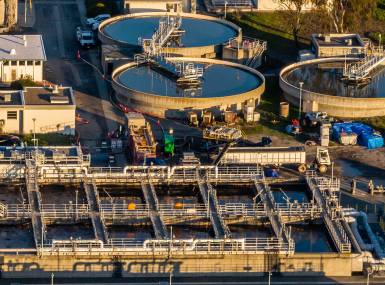Urge Congress and EPA to Consult with Counties on any Future Regulations on PFAS

Author

Charlotte Mitchell Duyshart
Upcoming Events
Related News
Action Needed
Urge the U.S. Congress, the Environmental Protection Agency (EPA) and other federal agencies to study the health and environmental impacts of Per- and polyfluoroalkyl substances (PFAS) compounds and to work closely with state and local governments on any regulatory or legislative actions related to PFAS.
Background
PFAS are a class of toxic chemicals that have been used for various purposes, including commercial, industrial and U.S. military applications. Some common uses include food packaging, nonstick coatings and fire suppressants used at U.S. military installations, airports and state and local fire departments.
Over the years, several studies have shown that exposure to PFAS above certain levels, particularly perfluorooctanoic acid (PFOA) and perfluorooctane sulfate (PFOS), is associated with various adverse health effects. This includes, but is not limited to, certain cancers, suppressed antibody response, reproductive problems and thyroid hormone disruption. PFAS chemicals are highly durable and can persist in the environment and the human body for years if exposed.
Detections of PFAS contamination in drinking water and the environment have increased in recent years. PFOA and PFOS have been detected in soil, surface water, groundwater and public water supplies in numerous locations. These detections have been associated primarily with releases from manufacturing and processing facilities, and from U.S. military installations and other facilities that use firefighting foams. As owners, users and regulators of water resources, counties play a key role in addressing the concerns with PFAS exposure.
Congressional and Administrative Action
EPA has taken several steps to address PFAS, including expanding nationwide monitoring of PFAS in drinking water, increasing data collection and initiating a national PFAS testing strategy under its Toxic Substances Control Act (TSCA) authorities. Much of EPA’s work is guided by the PFAS Strategic Roadmap, which was released in October 2021, and sets key deadlines for the agency to take specific actions and implement new policies to address PFAS.
Recent EPA rulemakings most relevant to counties include:
- On April 10, 2024, EPA released its National Primary Drinking Water Regulation (NPDWR) for six PFAS chemicals under the Safe Drinking Water Act (SDWA). Approximately 66,000 public drinking water systems will be subject to this rule and 6 to 10 percent will need to take action to reduce PFAS and meet the new maximum contaminant levels (MCLs).
- The compliance timeline for this final rule is tight. Public water systems must complete initial monitoring for PFAS by 2027 and all public water systems must comply with the new (MCLs) for PFAS by 2029. This rule is expected to place a significant burden on public water systems. Compliance costs will likely be passed onto consumers through rate increases and long-term debt, particularly where advanced treatment is required. This rule will take effect on June 25, 2024.
- On April 19, 2024, EPA designated two PFAS chemicals, PFOA and PFOS, as hazardous substances under the Comprehensive Environmental Response, Compensation and Liability Act (CERCLA), also known as the Superfund law. This designation authorizes the EPA to investigate releases of PFOA and PFOS and compel potentially responsible parties (PRPs), including owners and operators of facilities and vessels, to clean up contaminated sites or to reimburse EPA for the cost of cleanup.
- EPA released an enforcement discretion policy alongside the final rule stating that EPA will focus its enforcement actions on entities that significantly contributed to the release of PFOA and PFOS into the environment, including manufacturers of PFAS, parties that have used PFAS in the manufacturing process and other industrial parties. However, the enforcement discretion policy does not prevent other PRPs from suing county governments to recover cleanup costs. Additionally, the policy is not legally binding and nothing included in the policy prevents a future administration from revoking it.
- This final rule could place an economic burden on counties, as PFAS is often suspended in the environment and leads to accumulation in water systems and waste facilities. Given the pervasiveness of PFOA and PFOS, county governments, water utilities and landfills could be subject to the rule’s reporting and financial liability requirements. This rule will take effect on July 8, 2024.
Key Talking Points
- As owners, users and regulators of water resources, counties are directly impacted by federal regulation and legislation regarding PFAS.
- Counties support efforts by EPA and other federal agencies to study the health and environmental impact of PFAS compounds.
- As EPA moves takes regulatory action, counties urge the administration to work closely with state and local governments throughout the process.
- As Congress considers legislation to address PFAS, counties urge policymakers to consult with state and local governments throughout the process.
Related News

Congress examines PFAS liability and cleanup regulations
On December 18, the U.S. House Energy and Commerce Subcommittee on Environment held a hearing examining the current statutory and regulatory landscape for PFAS. The hearing follows a similar hearing held by the U.S. Senate Environment and Public Works Committee on November 19.
‘Fix-It Fair’ brings new life to damaged items, helps divert waste
Thurston County, Wash. partnered with a non-profit to help residents fix things that are difficult to recycle.

U.S. House of Representatives passes SPEED Act and other permitting reform bills
On December 18, the U.S. House of Representatives passed the SPEED Act (H.R. 4776). The SPEED Act would strengthen county involvement in decision-making and make needed commonsense reforms to the federal environmental review process.